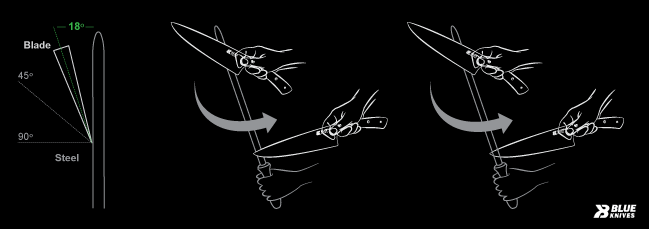| Wash After using your knife make sure to use a sponge and mild detergent to clean the blade of your knife. (Foods like tomatoes, limes and other acidic fruits and vegetables are especially corrosive and should never be left on the blade for extended periods.) Never put knives in the dishwasher. The extreme heat and water will damage the handle and blade of the Knife. |
| Dry Dry your knife with a dish cloth after cleaning. Be extremely careful not to cut your self when cleaning the Blade. (Never leave your knife in the sink, prolonged exposure to water can cause rust on the blade and damage the handle of the knife.) |
| Store Be sure to store your knife in a safe location where it will not be nicked or damaged. Magnetic knife racks and traditional knife blocks are both good places to store your knife. Note: When using a magnetic knife rack be sure not to let the force of the knife against the magnet chip the blade, always make sure the spine of the knife touches the magnet first. |
Keeping a sharp edge on your knife is easy. Regular use of a knife steel to hone the edge will keep a medium edge from becoming a dull edge. Using a steel will prolong the lifespan of your knife because unlike sharpening it doesn't remove steel. Never use a stone or glass cutting board. They will dull your knives very quickly. |  |
Honing |
|
|
|
| Sharpen You will also need to occasionally sharpen your knife using a whetstone to grind metal away from a dull edge. The 52100 steel used in your knife is much easier to sharpen by hand than stainless steel. For more information on sharpening your knife click here |
|
 |
|
| Removing Stains High Carbon steel will form a mild grey patina with normal use. While this will not damage the blade it is important to keep more aggressive forms of corrosion from damaging the blade. It is easy to keep your blade in great condition for decades. I recommend using a scotch bright pad, or very fine abrasive pad to remove surface corrosion. |
|
| Protecting the Handle The Stabilized hardwoods used in the handles are extremely durable. To protect the quality of the handle make sure that you knife is not exposed to water for extended periods. I put several coats of Danish oil on the handles after they are made, feel free to reapply if your handles seem to be drying out. |
|

